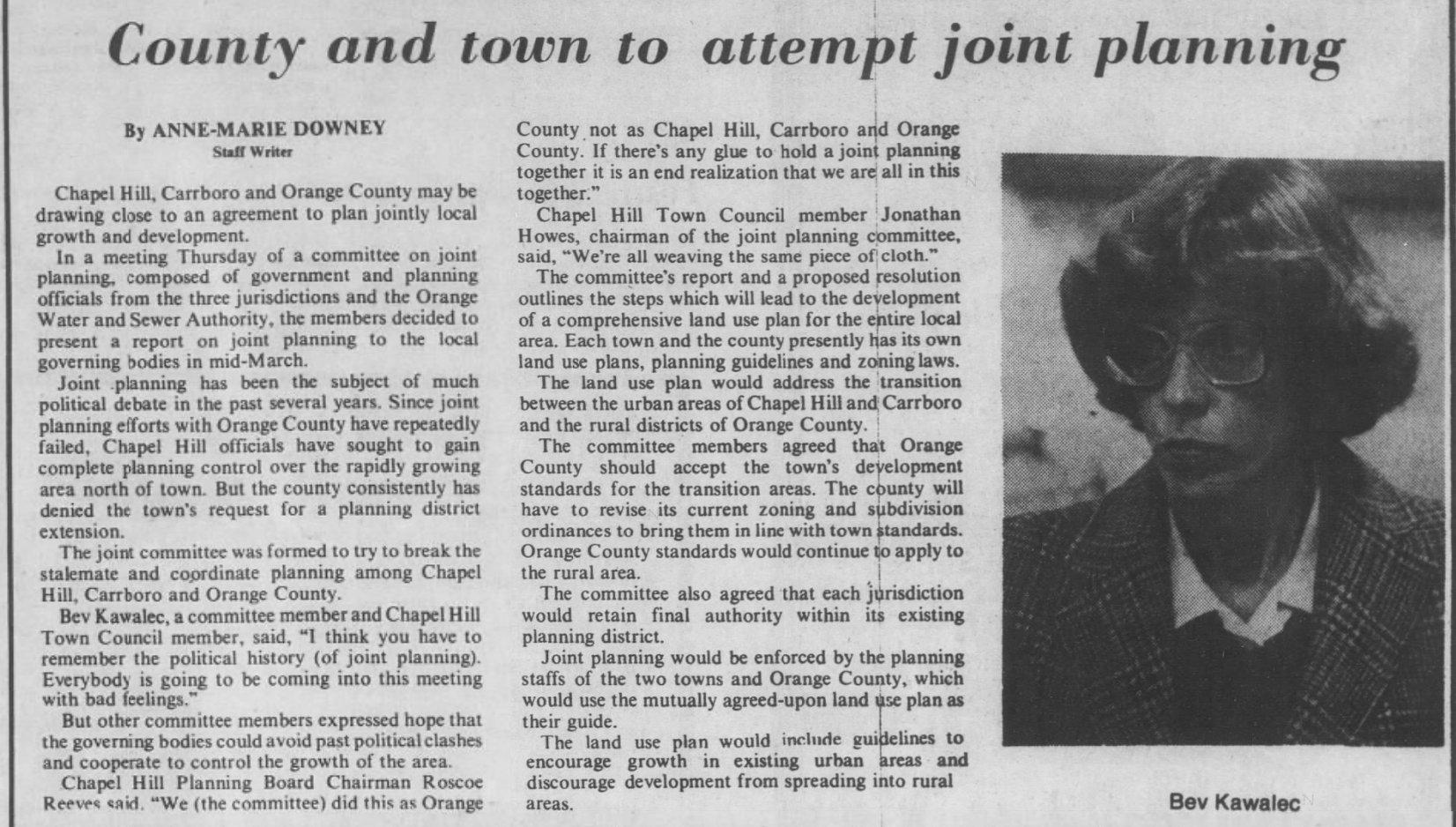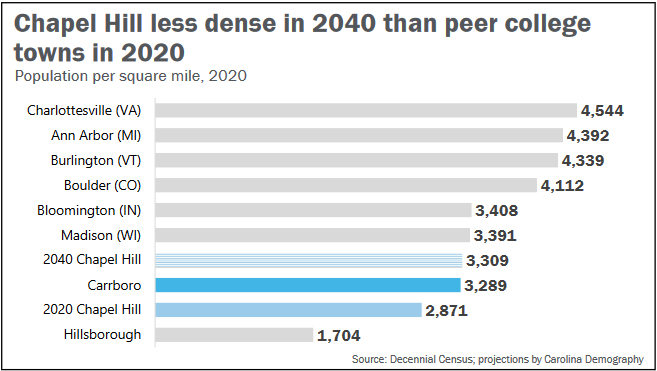There are two ways to think about land in Orange County.
In one version, we think about how land has been used historically. Our county was and remains largely rural, and much of that land is owned by private property owners, some of whom have been here for generations. If we focus on historic uses of land, we prioritize preservation above all else.
In another, we think about how land should be used in the future. Orange County is a slow-growing county, deliberately so, in a fast-growing region, which means that the price of the housing we do have continues to skyrocket. In Carrboro, the number of households making more than $200,000 a year has tripled since 2010, one of many indicators of how much we’ve changed in a short time. If we focus on future land use, we prioritize the need for housing.
In effect, our elected officials have to balance interests in retaining the physical landscape of our county with those in making sure that our current and future residents can prosper here.
Last night, the Orange County Board of County Commissioners voted 5-1 to approve revisions to WASMPBA that will allow approximately 300 acres of land alongside 15-501 in southern Orange County to be connected to water and sewer. As we noted earlier this week, this is land that was reserved for future possible development. And, because we know that there’s strong demand to live here, we can ensure that the housing that’s built is denser, more affordable, and more sustainable than what currently exists.
While there’s one more government body—OWASA—that needs to sign off on this change, the BOCC vote was the consequential one. And, as the discussions by the commissioners before the vote indicated, there’s a sense that some commissioners are thinking more deeply about how we use land in the county.
What does it mean to be an environmentalist?
In the 1970s, in a period of rapid growth, our towns and county governments worked together on joint planning that was predicated on the expectation that almost all of the future growth would take place in our towns, protecting rural areas from development.



But in the mid-1980s, anti-development individuals and groups gained political power in our towns, and effectively withdrew from the agreement before it was even finished. (Chapel Hill’s 1981 zoning code would have allowed for 75 percent of growth to take place in towns, but the Alliance of Neighborhoods slowed that down. Currently 55 percent of Orange County’s population lives in Chapel Hill and Carrboro, well below what our local governments wanted for our county’s future) The same Chapel Hill Town Council that supported the creation of the rural buffer in 1987 also voted to limit how much housing one could build in town, even though the success of the rural buffer was predicated on Chapel Hill’s willingness to accommodate new residents. People who were against growth, period, got what they wanted—slow growth in our towns, and almost no growth outside of them.

We made these decisions piece by piece, a planning agreement here, a historic district there. We built walls around our towns, claiming we’d welcome everyone who wanted to live here, and then built more walls around the most expensive and desirable neighborhoods. We used our zoning code to require developers to petition the town council for approval, creating towns built on the whims of individual council members and developers.
Many of the people paying the price of these decisions can’t afford to live in our community even though they work here. It’s the school teacher who drives in from Alamance County to teach in our schools. Or the nurse who misses their child’s hockey practices because they have to fight an hour of traffic. Or the small business owner who has to commute from Raleigh because that’s all they can afford. (Not surprisingly, some of the elected officials who got us into this situation, including former council members Julie McClintock, Joe Capowski, and Alan Rimer, wrote the BOCC yesterday in opposition to WASMPBA).
Changing course will also require such actions. Major land use changes happen over decades and half-centuries, not overnight.

A pivotal and difficult vote
Last night’s vote came at a pivotal time in our county. Chapel Hill and Carrboro are both working on rewriting their zoning codes, for the first time in decades. Orange County is reassessing its land use plan.
We have the opportunity to create a community that is open to all while protecting what really matters—our county, city, and state-owned parks and natural areas, our water supply and environment. This was echoed in a letter that the Orange-Chatham Group of the NC Sierra Club sent to the county commissioners yesterday, in which they said, that “extending the WASMPBA will serve Orange County’s climate goals, Chapel Hill’s housing, transit and climate goals, and enable our local governments to mindfully plan a more resilient, green future for the people of our county.”
Many of the commissioners last night spoke about the tradeoffs present in this decision, and how they thought about this potential expansion. Many touched on environmental concerns, and the idea that they wanted to protect the rural buffer and farmland.
Earl McKee focused on the $1 million+ plus homes that will appear without allowing for more dense housing: “Chapel Hill is not going to stop growing. Chapel Hill is not going to stop being attractive…and it is a major corridor into Chapel Hill. And for me, if you’re going to put sewer and water anywhere, it makes sense to put sewer and water along the major access corridors.”
Sally Greene focused on the idea for affordable housing coming out of the Chamber’s Big Bold Ideas program, an initiative with leaders from the public, private, and non-profit sector coming together to solve Chapel Hill’s thorniest problems: “What I keep coming back to is, this is not in the rural buffer. This is in an area that is in Chapel Hill’s planning jurisdiction. It is intentional of Chapel Hill to grow in this area….The idea is that it will adhere to Chapel Hill’s policies of complete communities….We can all agree that Chapel Hill has very rigorous processes for collecting input….there will be plenty of time for input and planning. This is Chapel Hill’s area to plan and I believe they will do a very responsible job with it.”
Anna Richards assured the audience that their input would be welcomed at future stages, including the planning processes to come: “Because it’s in the corridor it makes sense. And it’s within the Chapel Hill planning area. The other thing is that it does not affect the rural buffer. And Chapel Hill and Carrboro both recently renewed their commitment to maintain the rural nature on Smith Level Road. Those things give me some assurance that that part is maintained…”
Amy Fowler touched on the idea that Chatham County has grown rapidly just outside this area: “I agree that this affordable housing is only going to make a small dent, but if we don’t make any dents, it just gets worse. So the other point is vehicle miles traveled. If they’re not living here, they’re not going to be living somewhere else in Chapel Hill. They’re going to be driving from other surrounding counties.”
Jamezetta Bedford touched on a number of good points about the due diligence she did, and emphasized that this wouldn’t affect water supply: “I have waffled back and forth, back and forth, back and forth…I initially wanted to wait as we did our land use. But I’ve been reassured…that there will be enough water…”
Back to housing for a second
Last night, one of the most exciting things we heard was an aside from Judy Johnson, the assistant planning director of Chapel Hill, who was presenting to the commissioners. She said that there are things that Chapel Hill can do to ensure that the houses in this area remain affordable.
“Can we have maximum lots sizes?….Could we have maximum house sizes? If we limit the lot, limit the size of the homes – that is one way to limit the cost of the home. Land and house size do drive the cost,” she said.
More compact land usage and denser housing allow us to protect more green space, and ensure that future generations of residents can live closer to work, transit, and amenities. That’s good for Chapel Hill, and it’s good for Orange County.
